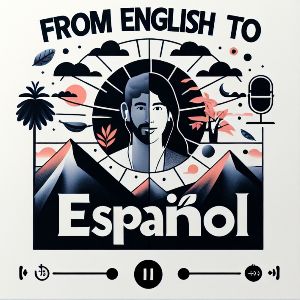Mastering "Ir + Gerund" in Spanish: Expressing Gradual Actions
May 09, 2025Categories: Spanish Language Learning, Lesson


From English to Español: Bridging the Grammar Gap with Alberto Rodriquez
Welcome to "From English to Español: Bridging the Grammar Gap", the podcast created specifically for English speakers ready to take their Spanish skills to the next level. Each episode dives into the core differences and surprising similarities between English and Spanish grammar, unraveling the complexities of the language in a way that’s clear, practical, and easy to follow. We'll break down essential concepts like verb conjugations, gendered nouns, and the tricky subjunctive mood, offering insights and tips that simplify these new rules and help you avoid common pitfalls. By comparing Spanish structures directly with English, you’ll quickly understand how to adapt what you already know into accurate, natural Spanish. Whether you’re a beginner or looking to brush up on advanced topics, this podcast is your comprehensive guide for bridging the gap between English and Spanish grammar, so you can speak and write with confidence. Join us daily for a new rule or concept, complete with practical examples, exercises, and memorable explanations that make learning Spanish engaging and enjoyable. Perfect for self-learners, students, and anyone serious about mastering Spanish grammar, "From English to Español" is your go-to resource for building fluency from the ground up.
Using the Verb "Ir" with Gerunds to Indicate Gradual Actions in Spanish
One of the fascinating aspects of Spanish grammar is how it expresses the progression or gradual unfolding of actions. For English speakers learning Spanish, understanding how the verb ir can be combined with gerunds to indicate a gradual or ongoing action is essential for fluency and natural expression.
The verb ir literally means "to go," but when used with a gerund (the -ando, -iendo form of verbs), it creates a special construction that conveys the idea of something happening little by little or gradually over time.
How Does "Ir + Gerund" Work?
In this construction, ir is conjugated according to the subject, and the main action verb appears in the gerund form. Together, they emphasize that the action is not happening abruptly but unfolds progressively.
For example:
- Ella va aprendiendo español. – She is gradually learning Spanish.
- La situación va mejorando. – The situation is getting better little by little.
- Voy entendiendo lo que dices. – I am slowly understanding what you say.
Here, the focus is on the process and development of the action rather than simply stating that it is happening right now.
Comparison with Other Progressive Tenses
It is important not to confuse ir + gerund with the more common estar + gerund, which simply expresses an action happening at this moment.
- Estoy aprendiendo español. – I am learning Spanish (right now).
- Voy aprendiendo español. – I am gradually learning Spanish (over time).
The difference lies in the nuance: estar + gerund highlights the current ongoing action, while ir + gerund emphasizes the gradual accumulation or progressive development of the action.
Examples in Context
- Carlos va mejorando su nivel de inglés.
Carlos is gradually improving his level of English. - El clima va cambiando a lo largo del día.
The weather is changing gradually throughout the day. - Los niños van aprendiendo a leer.
The children are gradually learning to read.
Exceptions and Nuances
While ir + gerund is widely used to describe gradual processes, there are some exceptions and points to consider:
- Not all Spanish speakers use it frequently: In some regions, speakers might prefer other expressions like poco a poco or use adverbs to indicate gradualness rather than the ir + gerund construction.
- Not used for immediately completed actions: If an action is instantaneous or fully completed, this construction is inappropriate. Instead, simple past or perfect tenses might be better.
- Avoid confusing it with seguir + gerund or continuar + gerund: These verbs also pair with gerunds but mean "to keep doing" or "to continue doing," which implies persistence rather than gradual progress.
Quick Practice
Transform these sentences using ir + gerund to indicate gradual action:
- Juan learns French. → Juan va aprendiendo francés.
- The plants grow. → Las plantas van creciendo.
- They are fixing the car bit by bit. → Ellos van arreglando el carro.
Notice how the sense of progress over time is emphasized in the transformed sentences.
Summary
Using ir + gerund is a subtle yet powerful way to express that an action is gradually taking place. It contrasts with estar + gerund (immediate ongoing action) and with verbs like seguir or continuar that focus on continuation rather than gradual progression. While it might not be the most common form in casual speech everywhere, mastering this construction allows learners to sound more nuanced and naturally expressive in Spanish.
For those eager to understand Spanish grammar in depth, Learn more at ScienceBasedLearning.com, where you can explore additional lessons and resources tailored for language learners. Get your copy of our comprehensive guides and enhance your Spanish skills today!
 |
Master A New Language With Science-Based Methods
|
Post Tags: